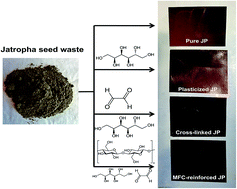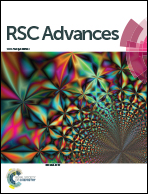Micro-fibrillated cellulose reinforced eco-friendly polymeric resin from non-edible ‘Jatropha curcas’ seed waste after biodiesel production†
Abstract
Eco-friendly polymeric resin with desirable mechanical and physical properties was developed from non-edible protein extracted from ‘Jatropha curcas’ (Jatropha) seed cake, so far considered as an agro-waste after oil extraction for bio-diesel conversion. A green, facile and cost-effective water-based casting and evaporation method was applied to fabricate Jatropha Protein (JP) based resin sheets. High molecular weight and the presence of reactive amino acids (a high content of arginine) in JP provide the basis to form a sustainable polymeric material. Also, JP resins were found to display diverse mechanical properties ranging from brittle and rigid to ductile and soft depending on the external modifiers such as plasticizer, cross-linker and reinforcing element used. Experimental studies using 10% sorbitol as a plasticizer, 10% glyoxal as a cross-linker and 20% microfibrillated cellulose (MFC) as a reinforcing element rendered JP resin with promising mechanical, thermal and physico-chemical properties. A favorable comparison between the modified JP and various polymers opens up possibilities for a sustainable alternative from non-edible protein-based agro-wastes that can reduce the dependency on biobased polymers from edible sources and petroleum based non-degradable polymers for applications such as fiber reinforced composites.


 Please wait while we load your content...
Please wait while we load your content...